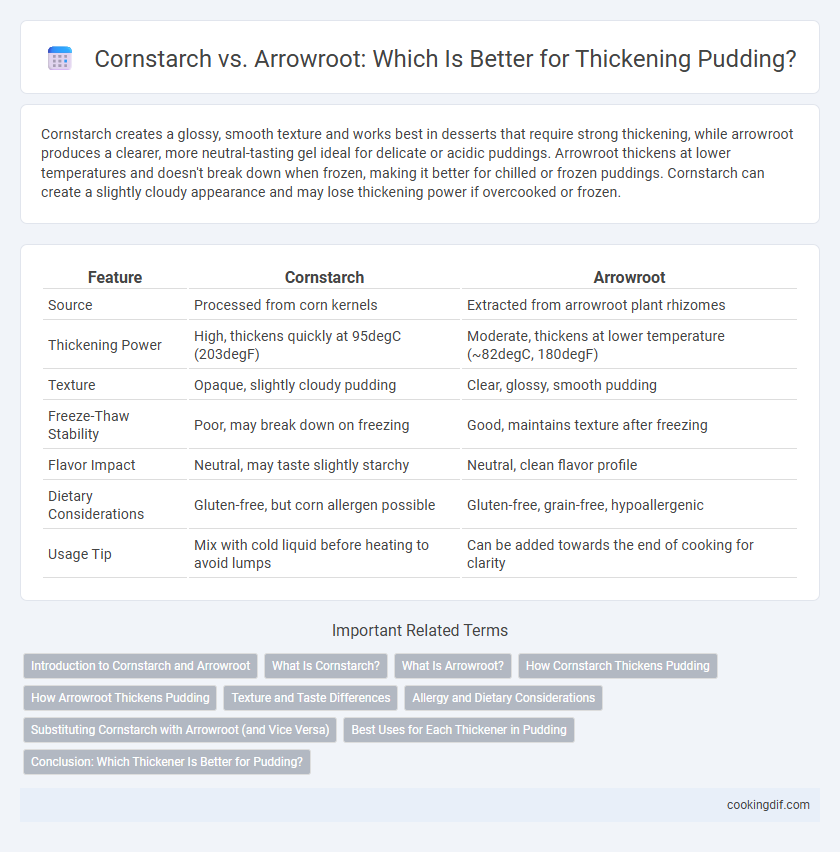Cornstarch creates a glossy, smooth texture and works best in desserts that require strong thickening, while arrowroot produces a clearer, more neutral-tasting gel ideal for delicate or acidic puddings. Arrowroot thickens at lower temperatures and doesn't break down when frozen, making it better for chilled or frozen puddings. Cornstarch can create a slightly cloudy appearance and may lose thickening power if overcooked or frozen.
Table of Comparison
| Feature | Cornstarch | Arrowroot |
|---|---|---|
| Source | Processed from corn kernels | Extracted from arrowroot plant rhizomes |
| Thickening Power | High, thickens quickly at 95degC (203degF) | Moderate, thickens at lower temperature (~82degC, 180degF) |
| Texture | Opaque, slightly cloudy pudding | Clear, glossy, smooth pudding |
| Freeze-Thaw Stability | Poor, may break down on freezing | Good, maintains texture after freezing |
| Flavor Impact | Neutral, may taste slightly starchy | Neutral, clean flavor profile |
| Dietary Considerations | Gluten-free, but corn allergen possible | Gluten-free, grain-free, hypoallergenic |
| Usage Tip | Mix with cold liquid before heating to avoid lumps | Can be added towards the end of cooking for clarity |
Introduction to Cornstarch and Arrowroot
Cornstarch and arrowroot are two popular starches used as natural thickeners in pudding recipes, each offering distinct properties and benefits. Cornstarch, derived from the endosperm of corn kernels, provides a clear, glossy finish and thickens quickly when heated, making it ideal for creamy, smooth puddings. Arrowroot, extracted from tropical plant rhizomes, thickens at a lower temperature, produces a translucent, velvety texture, and is preferred for its neutral taste and suitability in gluten-free and paleo diets.
What Is Cornstarch?
Cornstarch, a fine white powder derived from the endosperm of corn kernels, acts as a potent thickening agent commonly used in puddings to achieve a smooth, glossy texture. Its high starch content gelatinizes upon heating with liquid, forming a gel-like consistency that stabilizes and thickens the dessert. Compared to arrowroot, cornstarch creates a more opaque finish and holds up better under prolonged cooking or acidic conditions.
What Is Arrowroot?
Arrowroot is a natural starch extracted from the rhizomes of tropical plants, primarily Maranta arundinacea. It is prized for its neutral flavor, clear thickening properties, and ability to create a glossy finish in puddings compared to cornstarch. Arrowroot thickens at lower temperatures and remains stable when mixed with acidic ingredients, making it ideal for delicate desserts.
How Cornstarch Thickens Pudding
Cornstarch thickens pudding through a process called gelatinization, where its starch granules absorb water and swell when heated, creating a smooth, thick texture. The effective thickening temperature ranges between 144degF and 162degF (62degC to 72degC), at which point the starch molecules burst and release amylose, providing structure and viscosity. Cornstarch produces a glossy, stable pudding consistency that holds up well during cooling and storage.
How Arrowroot Thickens Pudding
Arrowroot thickens pudding by creating a clear, glossy texture due to its neutral taste and fine starch granules that swell and gelatinize at lower temperatures compared to cornstarch. It forms a smooth, stable gel without breaking down or becoming cloudy when exposed to acidic ingredients or prolonged heating. This makes arrowroot ideal for delicate puddings where clarity and a silky mouthfeel are desired.
Texture and Taste Differences
Cornstarch creates a glossy, smooth pudding texture with a slightly heavier mouthfeel, while arrowroot yields a clearer, silkier consistency that feels lighter on the palate. Taste-wise, cornstarch has a neutral flavor but can sometimes add a subtle chalkiness, whereas arrowroot offers a more delicate, slightly sweet taste that enhances the pudding's natural flavors. The choice between cornstarch and arrowroot impacts the overall sensory experience, making arrowroot preferable for fruit-based puddings and cornstarch ideal for creamy, dairy-rich recipes.
Allergy and Dietary Considerations
Cornstarch and arrowroot both thicken puddings effectively, but arrowroot is a preferred choice for allergy-sensitive diets due to its gluten-free and grain-free properties. Cornstarch, derived from corn, may pose a risk for individuals with corn allergies, whereas arrowroot, extracted from tropical plant rhizomes, is hypoallergenic and safe for most dietary restrictions including paleo and vegan. Selecting arrowroot supports clean-label recipes and allergen-friendly dessert options without compromising texture or clarity.
Substituting Cornstarch with Arrowroot (and Vice Versa)
Arrowroot can substitute cornstarch for thickening pudding, providing a clearer, glossy finish and a slightly more neutral taste. Use equal amounts of arrowroot powder in place of cornstarch, but reduce cooking time since arrowroot thickens at lower temperatures and breaks down if overheated. Cornstarch serves as a reliable substitute for arrowroot, maintaining opacity and requiring boiling to activate its thickening properties.
Best Uses for Each Thickener in Pudding
Cornstarch is ideal for creamy, glossy puddings due to its strong thickening power and smooth texture, making it perfect for custards and traditional dairy-based desserts. Arrowroot works best in fruit-based puddings and clear, delicate sauces, as it thickens at lower temperatures and produces a translucent finish without altering flavor. Both thickeners require careful temperature control to prevent thinning, with cornstarch offering more stability under heat and arrowroot providing a silkier, more neutral result.
Conclusion: Which Thickener Is Better for Pudding?
Cornstarch creates a denser, opaque pudding with a smooth texture, while arrowroot produces a clearer, silkier finish with a slightly glossier appearance. For classic, firm pudding textures, cornstarch is preferable due to its strong thickening ability and resistance to breaking down under heat. Arrowroot is better suited for delicate, fruit-based puddings or recipes requiring a transparent gel-like consistency without a cloudy finish.
Cornstarch vs Arrowroot for thickening Infographic

 cookingdif.com
cookingdif.com